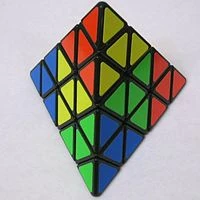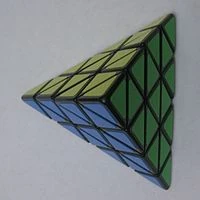
A basic pattern on a Master Pyraminx

A solved Master Pyraminx
The Master Pyraminx has 4 layers and 16 triangles-per-face (compared to 3 layers and 9 triangles-per-face of the original), and is based on the Skewb Diamond mechanism. This version has about 2.6817 × 1015 combinations. The Master Pyraminx has
- 4 "tips" (same as the original Pyraminx)
- 4 "middle axials" (same as the original Pyraminx)
- 4 "centers" (similar to Rubik's Cube, none in the original Pyraminx)
- 6 "inner edges" (similar to Rubik's Cube, none in the original Pyraminx)
- 12 "outer edges" (2-times more than the 6 of the original Pyraminx)
In summary, the Master Pyraminx has 30 "manipulable" pieces. However, like the original, 8 of the pieces (the tips and middle axials) are fixed in position (relative to each other) and can only be rotated in place. Also, the 4 centers are fixed in position and can only rotate (like the Rubik's Cube). So there are only 18 (30-8-4) "truly movable" pieces; since this is 10% less than the 20 "truly movable" pieces of the Rubik's Cube, it should be no surprise that the Master Pyraminx has about 10,000-times fewer combinations than a Rubik's Cube (about 4.3252 × 1019). It is designed by Katsuhiko Okamoto, although it was previously conceived by Aleksandr Ordynets. It is the logical next step up from the Pyraminx. Unlike the Pyraminx, the Master Pyraminx has centers.
A pillowed version is mass-produced by Meffert's. A flat version is mass-produced by ShengShou.